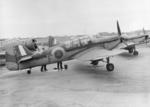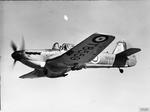M.9 Master
| Country | United Kingdom |
| Manufacturer | Phillips & Powis Aircraft Limited |
| Primary Role | Other |
| Maiden Flight | 3 June 1937 |
Contributor: Alan Chanter
ww2dbaseBy the mid-1930s as the British Royal Air Force had begun to take delivery of its first high-performance monoplanes it became clear that a trainer with similar performance characteristics would be required. Consequently Frederick G. Miles of the firm Phillips & Powis Aircraft Limited (to which Miles was a co-founder, together with Charles Powis and Jack Phillips) designed a low-wing monoplane training aircraft powered by the 745-horsepower Rolls Royce Kestrel XVI engine which was, at that time, in use in the RAF's Hawker Fury and Hart biplanes. Rolls-Royce had acquired a large financial interest in Phillips & Powis primarily to ensure a continuing market for the Kestrel engine, and the new aircraft acquired the same name. Of wooden construction, the Kestrel trainer was of exceptionally clean design but, unfortunately, the Air Ministry turned it down as being premature. Miles, undeterred, pressed on with the Kestrel's development as a private venture, and the first prototype aircraft made its maiden flight on 3 June 1937. In tests the Kestrel proved to have an exceptionally good performance, with a top speed of almost 300 miles per hour, a mere 20 miles per hour less than the latest Hawker Hurricane fighter, whose Merlin engine produced 350 horsepower. The Air Ministry then had a change of heart (with the failure of another trainer project which had been ordered) and, with nothing else in prospect, a £2 million contract was placed with Phillips & Powis, on 11 June 1938, to Air Ministry Specification 16/38. This, the largest contract placed to date for any trainer aircraft, was for a development of the Kestrel with the official name of M.9 Master.
ww2dbaseThe Air Ministry demanded a considerable number of modifications to the Kestrel in order to meet the Royal Air Force requirements. Changes were made to the windscreen, cabin top, rear fuselage and tail unit. The radiator was moved back from beneath the engine to a new position under the wing centre-section, and the engine was changed to the de-rated 715-horsepower inline Kestrel XXX. Unsurprisingly, these changes came with a considerable cost in performance - the Master having a top speed some 70 miles per hour less than the Kestrel but, even so, it was still the best trainer of the day, and had handling characteristics very similar to those of the new Hurricane and Spitfire fighters. Like the Kestrel the Master I was of wooden construction, covered with plywood. A sliding canopy soon replaced that of hinged design fitted on early aircraft, and in 1942 the round wingtips were removed in favour of square-cut tips, reducing the span by 3 feet 2 inches to 39 feet. A popular feature with pilots was the provision of a hand control box of Miles design; mounted on the port side of the cockpit which incorporated controls for throttle, mixture, propeller, landing gear, trailing-edge flaps, landing lights and elevator and rudder trim tabs - all easily accessible to the pilot's left hand.
ww2dbaseThe first of 900 production M.9A Master Mk.I flew on 31 March 1939, although just seven had entered service by the outbreak of World War II. Most of the Master I aircraft (easily recognizable by their ungainly radiator installation) went to the Flying Training Schools at Sealand in Wales, Hullavington in southern England, and Montrose in Scotland. In addition to their use in a training role some Master I aircraft were also attached to squadrons for ferrying pilots. During the Battle of Britain twenty-six Master I aircraft were converted to single-seat configuration and equipped with six 0.303-in Browning machine-guns as an emergency measure. None of these, designated M.24 Master I, would actually be employed in combat.
ww2dbaseBefore the Master I entered production, the Air Ministry asked Miles to modify an airframe to accept the 870-horsepower Bristol Mercury XX radial engine since the Rolls-Royce Kestrel was no longer in production, and the dwindling stocks of these engines was thought to be insufficient to meet production requirements. The Mercury-engine M.19 Master Mk. II made its first flight in November 1939 and undertook service trials during the same month. With this power-plant the Master II was some 16 miles per hour faster than its predecessor
ww2dbaseAt this point the Air Ministry discovered that it had no stocks of Mercury engines available, and so, during 1940, an 825-horsepower Pratt & Whitney Twin Wasp Junior engine was installed in a modified airframe and flown as the M.27 Master Mk. III. This was some 10 miles per hour slower than the Master II, but was otherwise satisfactory. By the time it had completed its trials, however, the Ministry had located further stocks of Mercury engines, and so both the Master II and III were placed into production simultaneously. Assembly lines Woodley and South Marston built the Mk.II, while the Mk.III was only built at South Marston. Ultimately a total of 1,747 Master II and 602 Master III would be built before the two production lines were diverted to the manufacture of other types (Martinet target tug aircraft at Woodley and Spitfire fighters at South Marston).
ww2dbaseA unique feature on all variants of the Master trainers was the instructor's seat in the rear cockpit. This could be raised to provide a better view over the head of the pupil in the front seat during take–off and landing. Interconnected with the seat raising mechanism was a hinged panel in the cockpit canopy which when raised automatically provided the instructor with a separate windscreen.
ww2dbasePrior to the outbreak of war RAF pilots received almost 150 flying hours' instruction and practice before being posted to squadrons. On mobilisation, however, there were few facilities or personnel available to polish newly-trained pilots, and so the final stage of a pilots training was undertaken at Group pool or Reserve squadrons within each Group. By 1941 such advanced training units became known as Operational Training Units (OTUs). Hence, the progress of any trainee pilot now became eight weeks ground instruction at an Initial Training Wing (ITW); 10 weeks of flying and ground lessons at an Elementary Flying Training School (EFTS); followed by up to 16 weeks at a Service Flying Training School (SFTS) on advanced flying practice (the Miles Master offering valuable high-speed experience for pilots destined to serve with fighter squadrons); then on to an OTU for the final 4-6 weeks getting used to the actual type of aircraft they would be flying on operations and learning valuable combat skills from instructors being rested after completing operational tours. Overall, therefore, new pilots would receive some 200 flying hours in their log books before commencing operational duties.
ww2dbaseA few Master II aircraft were used for experimental purposes. One was fitted with underwing rockets to assess its suitability as an armed trainer and, in 1942, when an Air Ministry requirement arose to replace the Hawker Audax and Hector biplane in the light glider-tug role, Miles were able to deliver a suitably modified aircraft for service trials within five days. This incorporated a towing hook in the rear fuselage with a release mechanism in the cockpit. The trials were completely successful and a number of other airframes were similarly converted to tow Hotspur gliders.
ww2dbaseIn addition to the Royal Air Force a number of Master aircraft were supplied to overseas military customers. One was transferred to the US Air Force, twenty-six went to Egypt, eighteen to Turkey, and some 450 Master II aircraft were shipped to South Africa. In addition one Master aircraft was acquired by Portugal and a Master III aircraft went to the Irish Air Corps. By the time production ceased in 1942 to allow the production facilities at Woodley to switch to building the Martinet target-tug (itself based much on the Master II) a total of 3,227 Master aircraft had been built; these proving to be the most significant advanced trainer of indigenous design to serve with the RAF during the Second World War.
ww2dbaseIn 1943, Rolls-Royce's interests were bought out of the firm Phillips & Powis Aircraft Limited, and the company was renamed Miles Aircraft Limited.
ww2dbaseSources:
David Mondey: British Aircraft of World War II (Chancellor Press, 1994)
World Aircraft Information Files, File 901/27 (Aerospace Publishing Periodical)
Chaz Bowyer: Royal Air Force Handbook 1939-45 (Ian Allan Ltd, 1984)
Last Major Revision: Dec 2017
M.9 Master Timeline
| 3 Jun 1937 | The M.9 Kestrel prototype aircraft took its first flight. |
| 11 Jun 1938 | The British Air Ministry placed a £2 million contract with Phillips & Powis Aircraft Limited to develop a new trainer aircraft based off of the M.9 Kestrel design. |
| 31 Mar 1939 | The first M.9A Master aircraft took flight. |
SPECIFICATIONS
M.19 Master II
| Machinery | One Bristol Mercury XX 9-cyl, air-cooled, radial piston engine rated at 870-hp |
| Armament | Provision for one fixed forward-firing 0.303-in Vickers machine gun and practice bombs |
| Crew | 2 |
| Span | 11.89 m |
| Length | 8.99 m |
| Height | 2.82 m |
| Wing Area | 21.83 m² |
| Weight, Empty | 1,947 kg |
| Weight, Loaded | 2,828 kg |
| Speed, Maximum | 389 km/h |
| Service Ceiling | 7,650 m |
| Range, Normal | 632 km |
Photographs
 |  |  |  |
Please consider supporting us on Patreon. Even $1 per month will go a long way! Thank you. Please help us spread the word: Stay updated with WW2DB: |

- » Wreck of Teruzuki Found (27 Jul 2025)
- » USS Orlean's Bow Found (22 Jul 2025)
- » The Emperor of Japan Planned to Honor WW2-era Japanese POWs in Mongolia (4 Jul 2025)
- » US State Lawmaker John Winter Caught Using Racial Slur "Jap" and Apologized (11 Jun 2025)
- » US Government Plans to Purge WW2 Information (17 Mar 2025)
- » See all news
- » 1,182 biographies
- » 337 events
- » 45,119 timeline entries
- » 1,248 ships
- » 350 aircraft models
- » 207 vehicle models
- » 376 weapon models
- » 123 historical documents
- » 261 facilities
- » 470 book reviews
- » 28,409 photos
- » 365 maps
Lt. Gen. Lewis B. "Chesty" Puller, at Guadalcanal
Please consider supporting us on Patreon. Even $1 a month will go a long way. Thank you!
Or, please support us by purchasing some WW2DB merchandise at TeeSpring, Thank you!